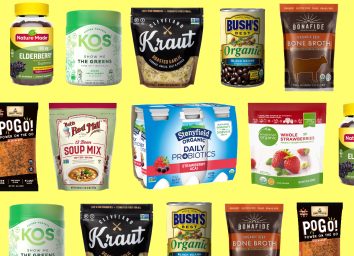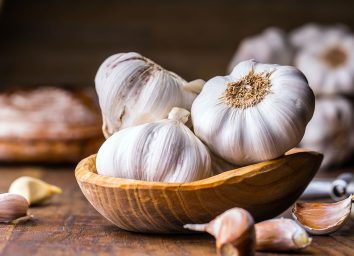20 Healthy Foods to Add To Your Coronavirus Grocery List
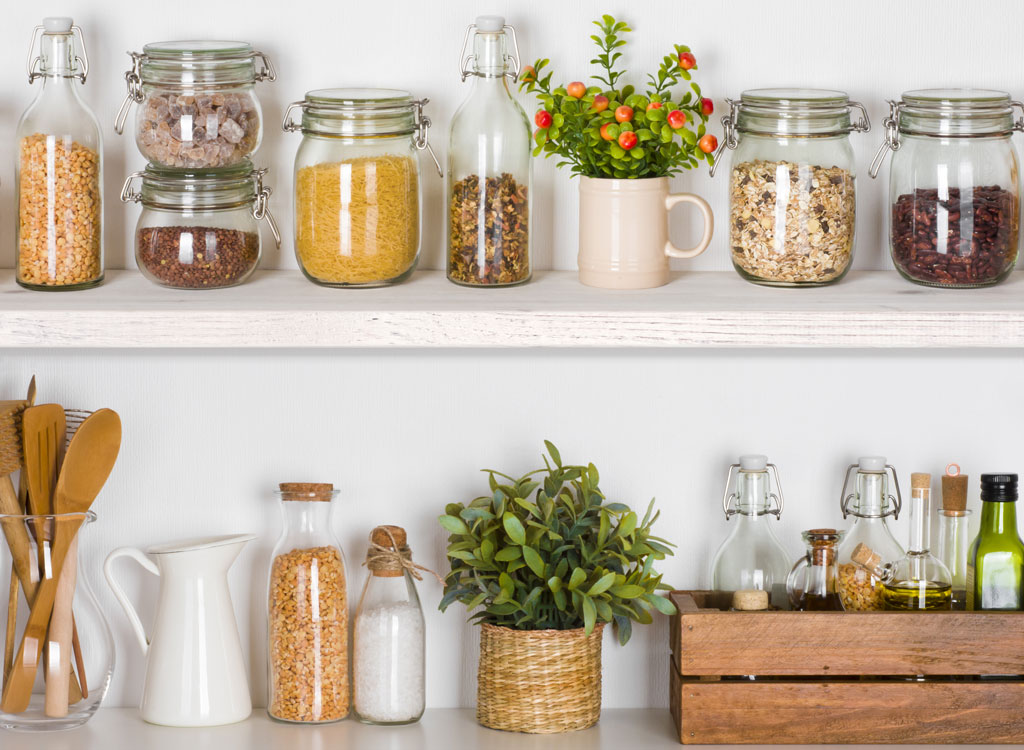
In the face of fears surrounding COVID-19, it’s entirely practical (and even recommended) to practice emergency preparedness. That doesn’t mean you should run to the nearest supermarket and buy up all the cans available—remember that hoarding food hurts communities! But think of this time as an exercise in smart and practical shopping. That means investing in versatile foods with a long shelf-life that will also nourish you in the most nutritious way possible during the coronavirus quarantine.
You don’t have to be concerned that grocery stores are going to run out of stock. But the benefit of keeping a stocked pantry is that it will help you limit the number of times you leave the house. Plus, when you have a pantry full of healthy food items, it can help you maintain a sense of calm and readiness.
What makes a well-stocked pantry? You’ll want to include healthy items that:
- Pack a nutritional punch
- Keep well over time
- Are convenient
- Provide a good balance of nutrients from a variety of food sources
- Are a combination of shelf-stable and fresh, nutrient-dense whole foods
Here are some healthy foods that Maya Feller, MS, RD, CDN, a registered dietitian nutritionist who specializes in weight management and owner of Brooklyn-based Maya Feller Nutrition, recommends adding to your “coronavirus grocery list.”
1. Dried or canned beans and legumes
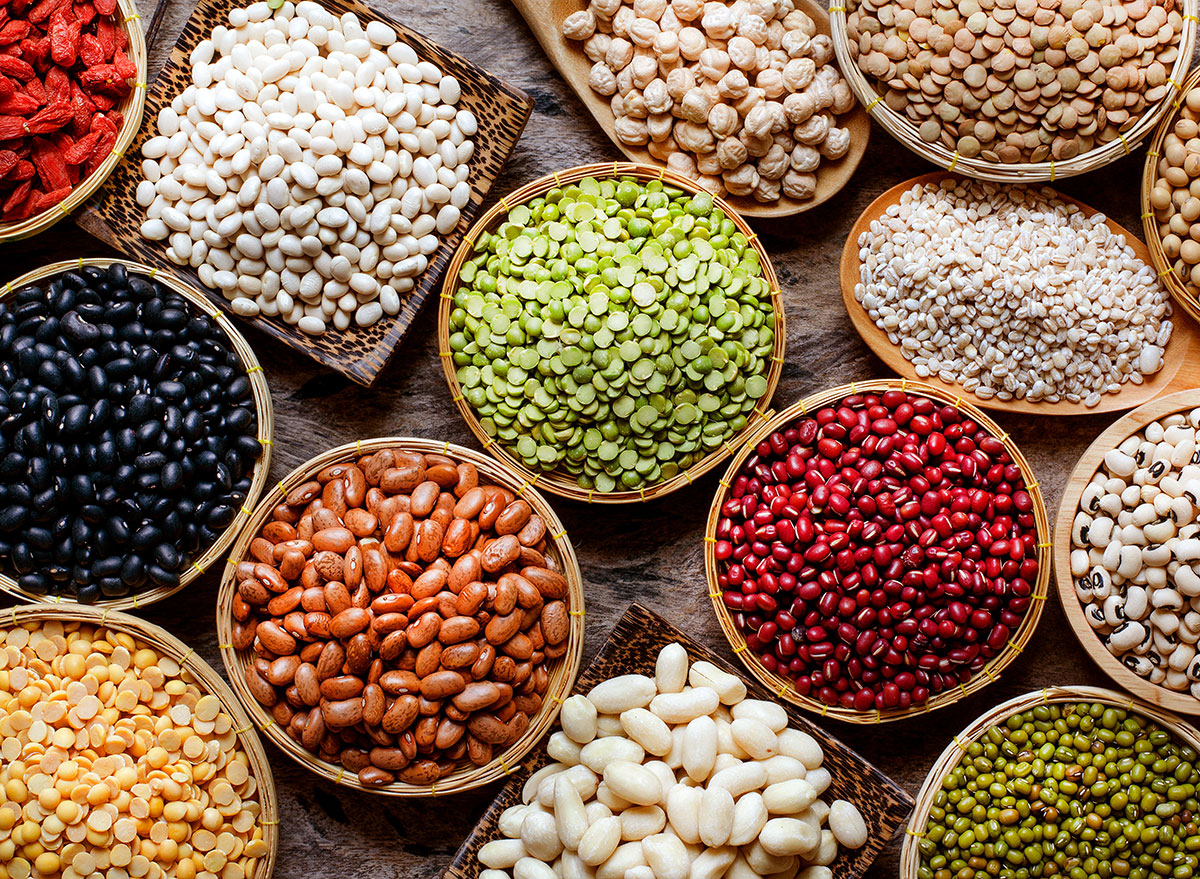
- Chickpeas
- Pinto beans
- Black beans
- Cannellini beans
- Black-eyed peas
- Red kidney beans
- Split peas
- Lentils
- Lima beans
When you’re building a healthy pantry, it’s more convenient to stock plant-based sources of protein than it is animal protein. One of the best picks is dried beans or, for a quicker option, canned beans. Feller says, “beans are a good source of plant based protein and fiber.”
Keep in mind that both canned and dried beans have their strengths and weaknesses, and choosing to go one way or another will largely depend on what you’re looking for in a bean. Dry beans are usually more cost-effective and tastier, plus there are a lot more varieties to choose from than in the canned goods aisle. On the other hand, they take some planning ahead, because they need soaking and quite a bit of time to cook. Canned beans are definitely more convenient, but you’ll want to watch the sodium levels in the cans you’re choosing (we recommend going low-sodium.)
Recipes to try: 20 Healthy Chickpea Recipes, Pinto Easy Homemade Smoky Baked Beans Recipe, 17 Simple Recipes to Make With a Can of Beans, Copycat Olive Garden Pasta Fagioli, 15 Healthy Recipes for Balck-Eyes Peas, Crock Pot Vegetarian Chili, Perfectly Creamy Split pea Soup, 20 Wholesome Lentil Recipes, The Easy Succotash
2. Whole grains
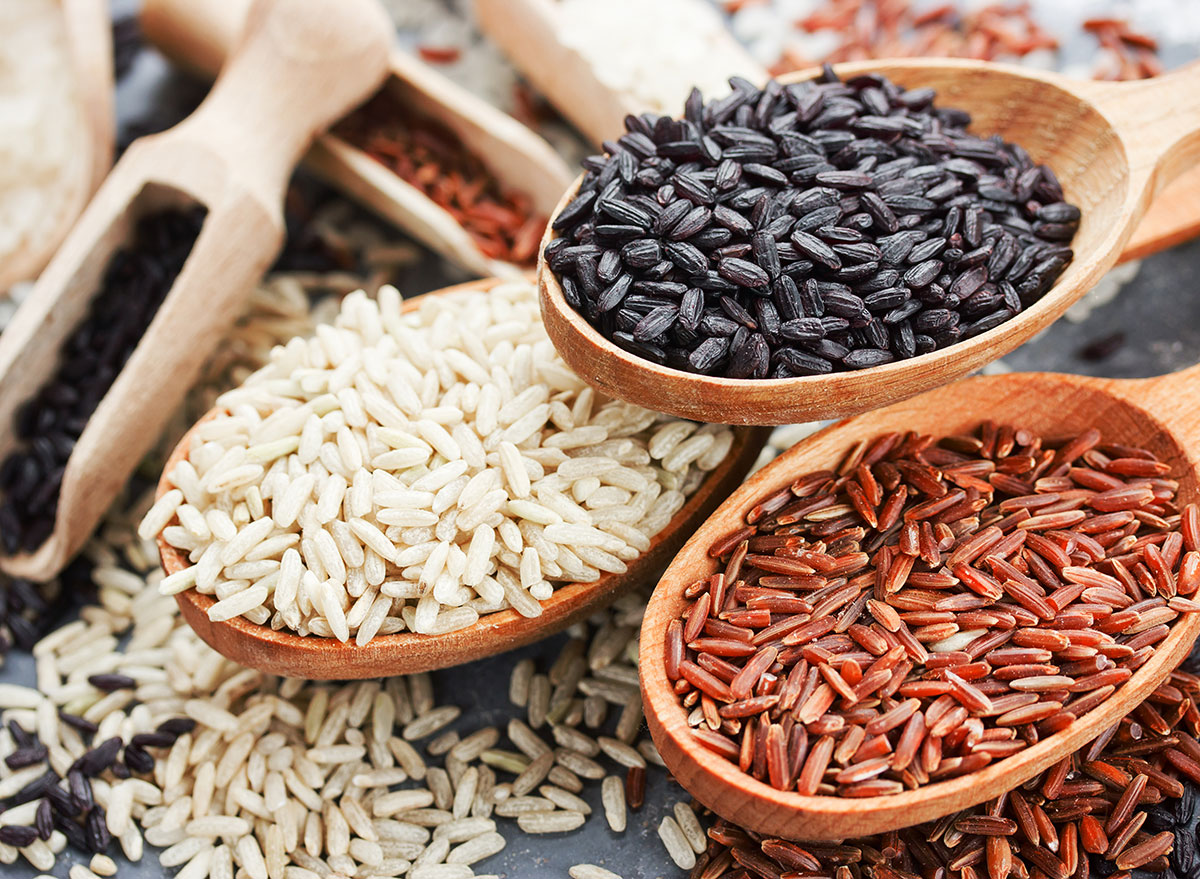
- Brown rice
- Black rice
- Red rice
- Buckwheat
- Barley
- Farro
- Oats
- Quinoa
- Amaranth
- Millet
- Sorghum
- Teff
Whole grains are a good source of B vitamins, says Feller. B-complex vitamins (a group of eight B vitamins) provide a variety of health benefits. Most notably, they’re associated with managing energy levels, relieving stress, and boosting cognitive performance—all great benefits when you’re cozying up at home. And let’s be real, your lifestyle is about to become a lot more sedentary, so maintaining optimal amounts of fiber in your diet is crucial to keeping your digestion regular.
Another great way to stock up on fiber-rich whole grains is to buy whole-grain bread. It can freeze indefinitely, and nothing beats a good sandwich. Get inspired by our list of best breads and best sandwiches.
Recipes to try: 23+ Healthy Fried Rice Recipes, 30 Healthy Bowl Recipes, 34 Quinoa Recipes for Weight Loss, 51 Healthy Overnight Oats Recipes, 9 Fantastic Farro Recipes
3. Pasta
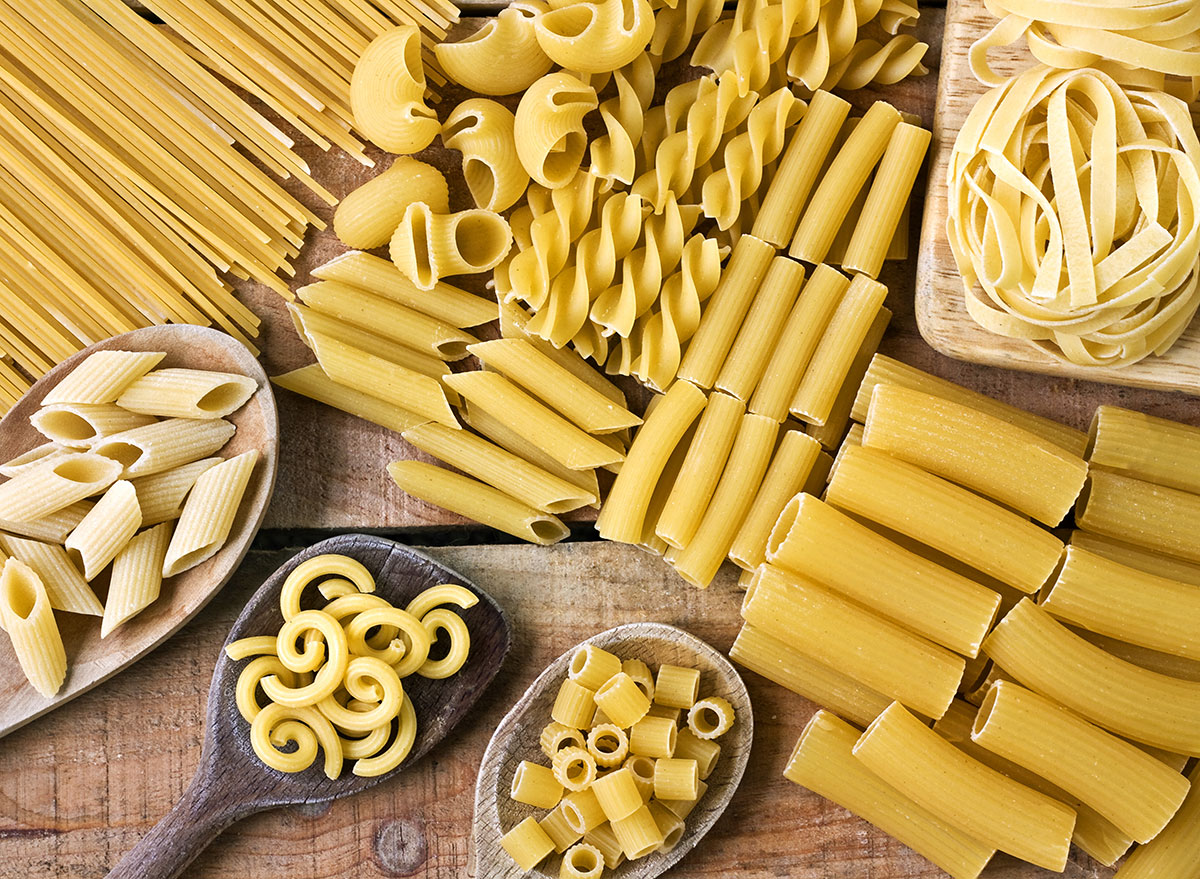
- Regular pasta
- Gluten-free pasta
- Whole grain pastas
- Bean-based pasta
There’s no reason to fear carbs, and that especially applies to pasta. You have a variety of different options to choose from, and Feller notes that each can boost your health in its own way.
For example, bean-based pastas are a good source of protein, gluten-free pasta made from corn and quinoa is a good source of antioxidants, and whole grain pastas are a good source of B vitamins.
Recipes to try: 20 Fat-Burning Pasta Recipes, 53+ Healthy Italian Recipes
4. Canned, boxed, or jarred tomatoes
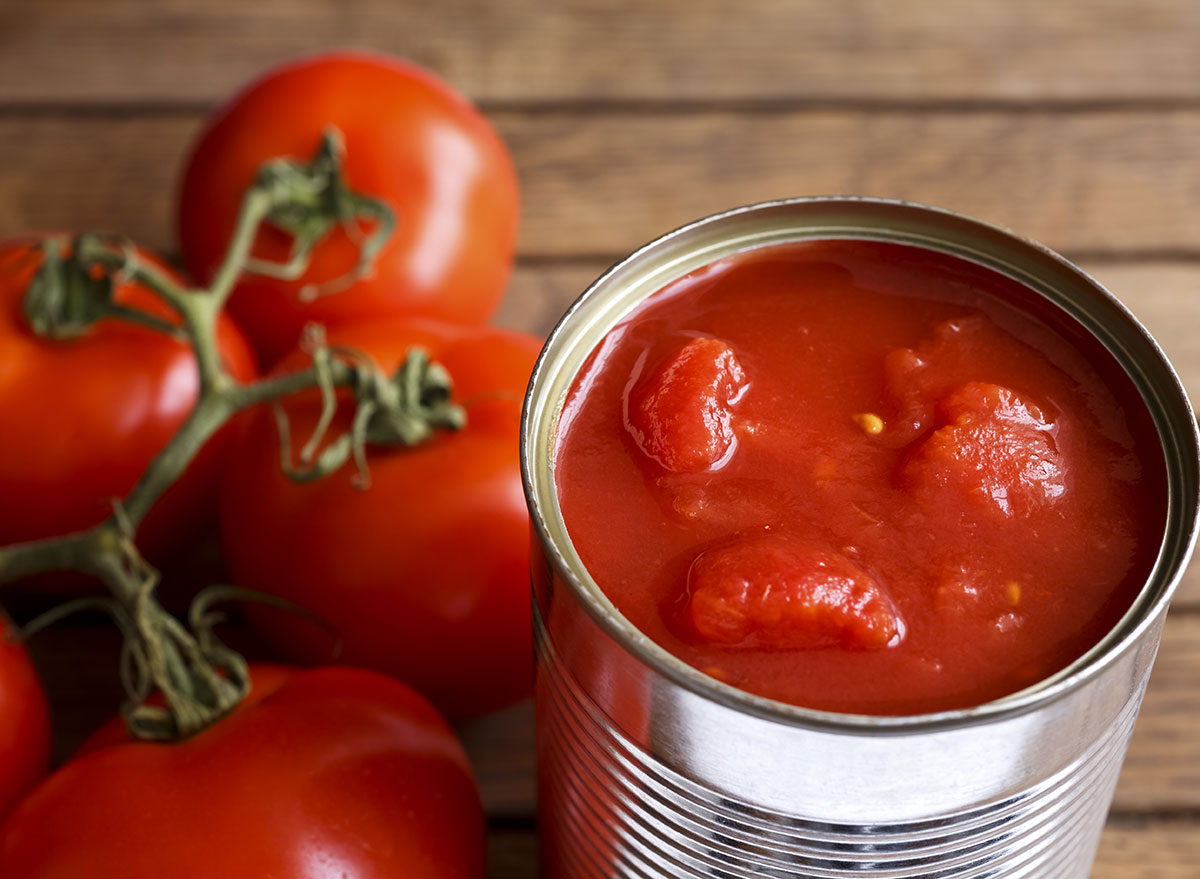
What better to stock alongside your pasta than tomato sauce? Feller says tomatoes are rich in lycopene, a potent antioxidant, and vitamin C. This is a stressful time for everyone, and if you’re worried about your immune system, rest assured that vitamin C is the nutrient to ramp up in your diet. The antioxidant vitamin has been shown to help people cope with stressful situations and treat anxiety as well as keep your immune system running smoothly.
And just think about it—you need tomato sauce for pretty much everything, from pasta, soups, stews, shakshuka, baked beans, pizza sauce, and more. Plus, there are some ingenious ways of using leftover sauce, should you have an open jar kicking around your fridge.
Recipes to try: Best Paleo Shakshuka, 5-Ingredient Salsa, Veggie Minestrone Pesto Soup, Hearty Italian Sausage Soup, A Hearty Low-Cal Bolognese Sauce, Meatballs and Polenta, Chicken Sausage Lasagna
5. Winter squash

- Butternut squash
- Acorn squash
- Pumpkin
- Spaghetti Squash
- Delicata squash
“Depending on the type, [winter squash varieties contain] varying amounts of potassium and vitamins A and C,” says Feller. If you want to avoid getting cramps from chilling on the couch all day, potassium will be your best friend. The electrolyte will help you and your muscles stay hydrated. A cup of acorn squash serves up to 19 percent of your daily value of the nutrient, while butternut squash contains 12 percent.
It might sound odd to consider squash a solid pantry item, but squash stores surprisingly well. If you keep fresh, uncut squash in a cool, dry, dark place, your squash should last between one to three months.
Recipes to try: 20 Healthy Butternut Squash Recipes, 20 Spectacular Spaghetti Squash Recipes
6. Potatoes
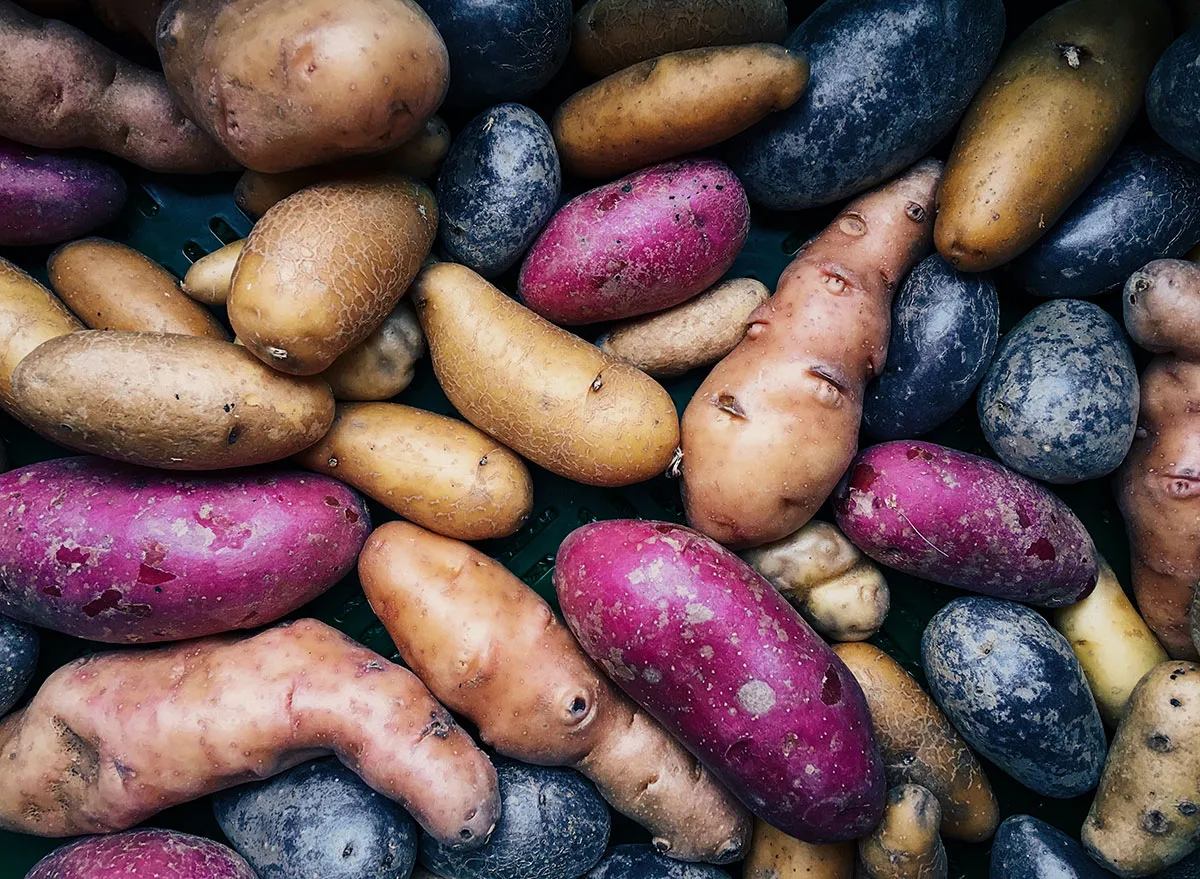
- White potatoes (russet, red, yellow, Yukon Gold)
- Sweet potatoes
Potatoes get a bad rap, but they’re actually a very healthy pantry (and diet) staple. They are some of the most filling, satisfying foods (which can prevent you from eating too soon after your last meal, causing you to consume more calories than you need).
All varieties of white potato are a good source of B and C vitamins, while sweet potatoes are a good source of A and C vitamins as well as potassium, according to Feller.
If you’re stocking up on tubers, make sure you store them properly to prevent them going to waste.
Recipes to try: 13 Creative Potato Recipes, 25 Healthy and Delicious Sweet Potato Recipes
7. Carrots

Carrots are one of Feller’s pantry staples not only because they’re a source of vitamins A and C, but also because they keep for weeks and can be used in a variety of snacks and dishes. Fresh or frozen works equally well for most recipes!
You’ll be hard-pressed to find a soup recipe that doesn’t call for carrots, but you can also roast them as a vibrant side dish, and even use them in smoothies.
Recipes to try: Simple, Delicious Roasted Carrots, Plant-Based Carrot Cake Smoothie, Classic Herb Roast Chicken with Root Vegetables
8. Citruses
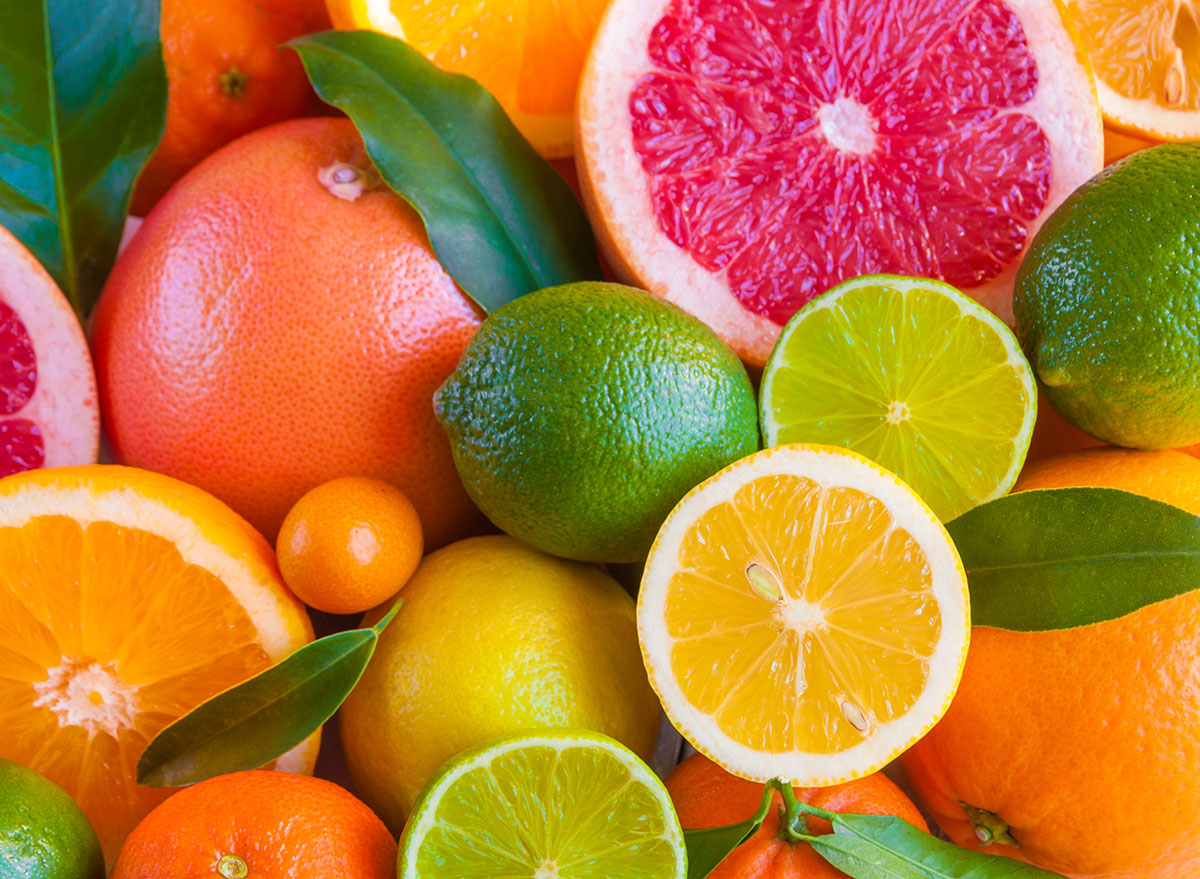
- Lemon
- Lime
- Orange
- Mandarin
- Clementine
- Grapefruit
Citruses are a star-studded cast when it comes to hard-working pantry additions. They’re bursting with vitamins and antioxidants, but are also an important culinary staple. Acidity is one of the main flavor components of food, and without it, dishes can end up tasting as bland as if they were unsalted. Use lemon juice in salad dressings, soups, sauces, cakes, and crock pot creations, and even zest it into pasta dishes and vegetables.
Grapefruits and oranges make wonderful salads and juices, too!
Recipes to try: Arugula and Grapefruit Salad, 20 Grapefruit Recipes for Weight Loss, Easy Garlic Lemon Spinach Recipe, Instant Pot Lemon Cake, Instant Pot Lemon Chicken, 15 Ways to Lose Weight With Lemons
9. Fresh fruit with a long shelf life
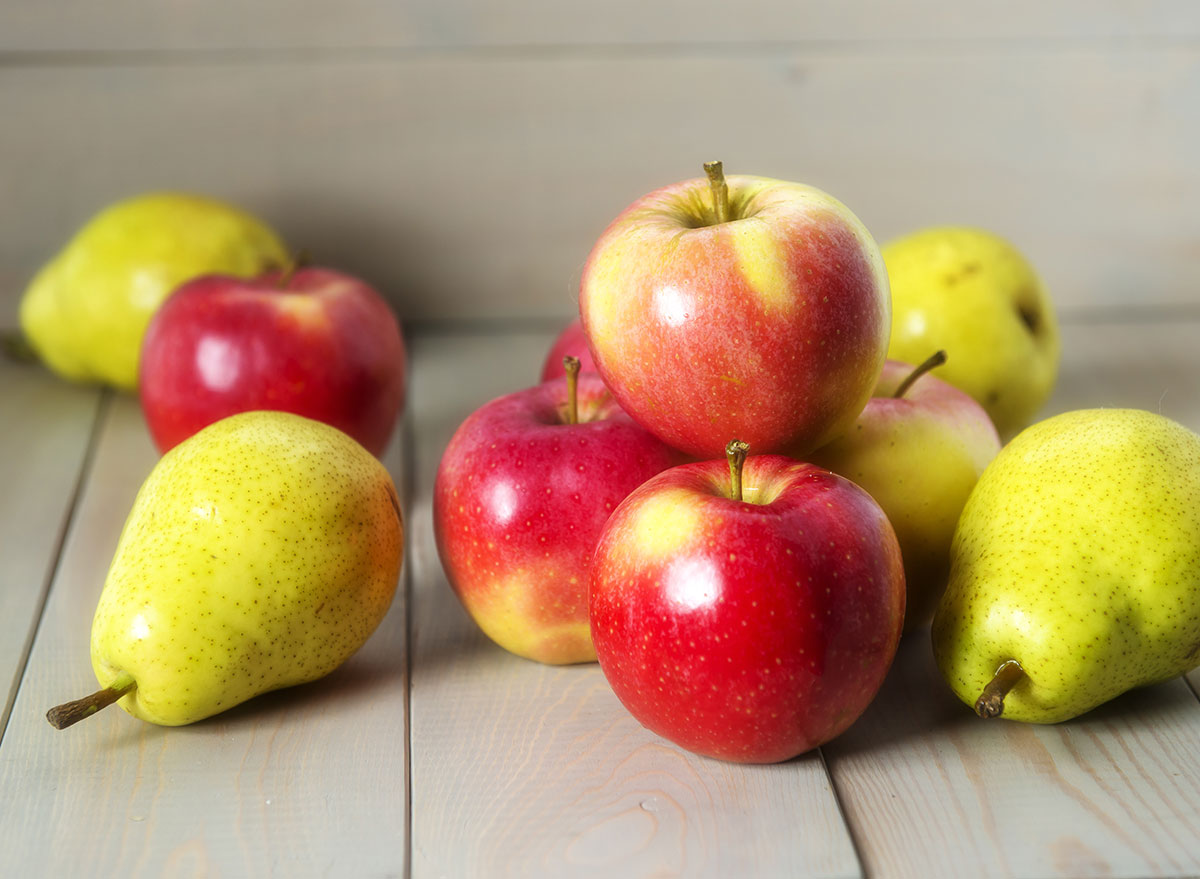
- Apples
- Pears
When fresh leafy greens are limited, Feller recommends looking to fruits as good sources of fiber. Apples and pears are particularly reliable because they can last a while in the fridge before losing their juicy texture. Add them to salads, use them in baking, or make applesauce!
And if you’re looking for more shelf-stable options, canned or jarred applesauce is always a vitamin C-rich option.
Recipes to try: Warm Goat Cheese Salad With Pears, Pear Cardamom Oats Smoothie, Teriyaki Pork Chops With Sautéed Apples, Warm Apples with Caramel Drizzle, Easy Apple Cranberry Crisp, The Flakiest and Crispiest Apple Turnover
10. Frozen fruit
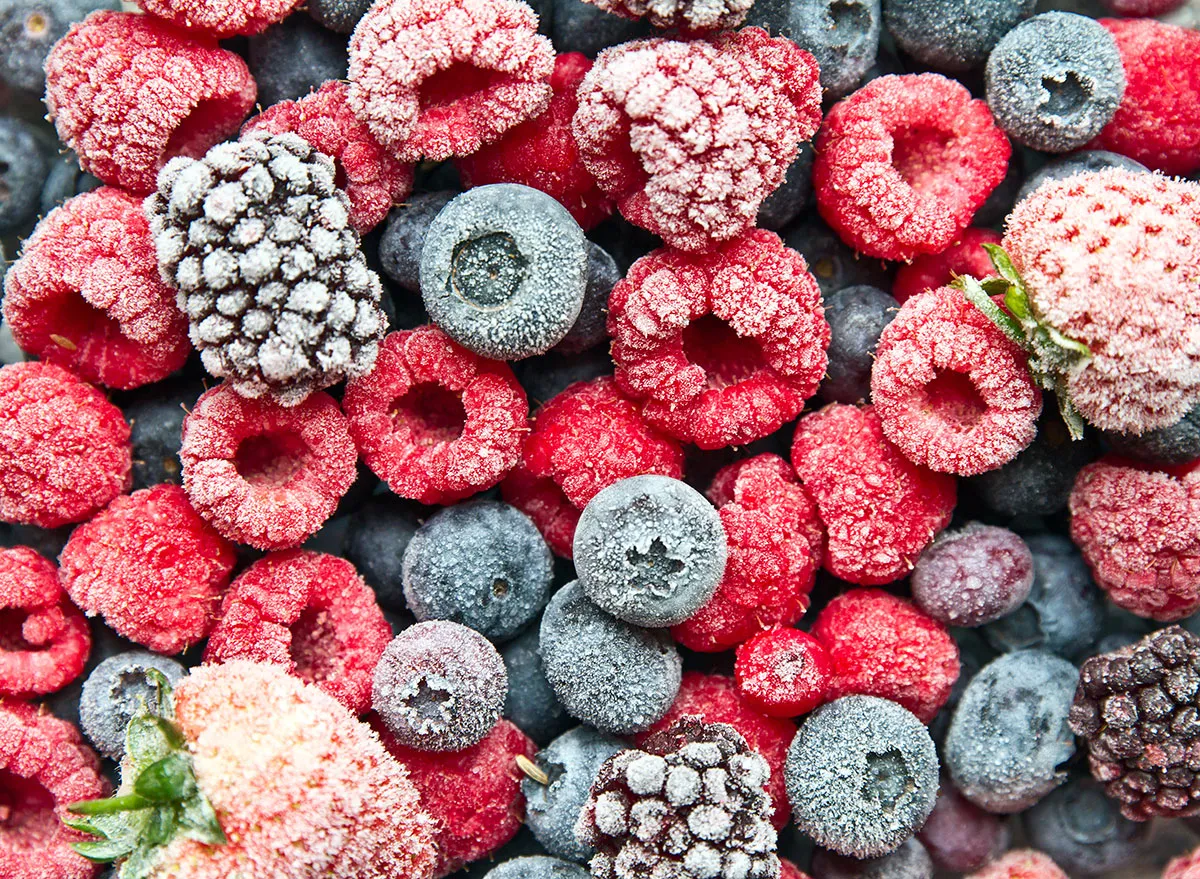
- Strawberries
- Blueberries
- Blackberries
- Raspberries
- Cherries
- Peaches
- Pineapple
Frozen fruits are packed at peak ripeness, meaning they don’t lag behind their fresh counterparts when it comes to nutrition. You can easily use antioxidant-packed berries, peaches, and pineapples in smoothies. (Just be sure to add some protein powder, healthy fats, and fiber-rich seeds for a well-rounded meal-replacement smoothie.)
Frozen fruits also make the perfect breakfast item or snack. Simmer some mixed berries on the stovetop with a splash of water and lemon juice to make a jammy syrup for topping plain yogurt, or add some frozen blueberries to your oatmeal before microwaving it—they’ll warm up and add some color and sweetness to your breakfast.
Fun fact: If you have fresh bananas, you can cut them up and freeze the chunks on a sheet-pan to use in smoothies for days to come.
Recipes to try: 53 Best Ever Breakfast Smoothies
11. Frozen vegetables
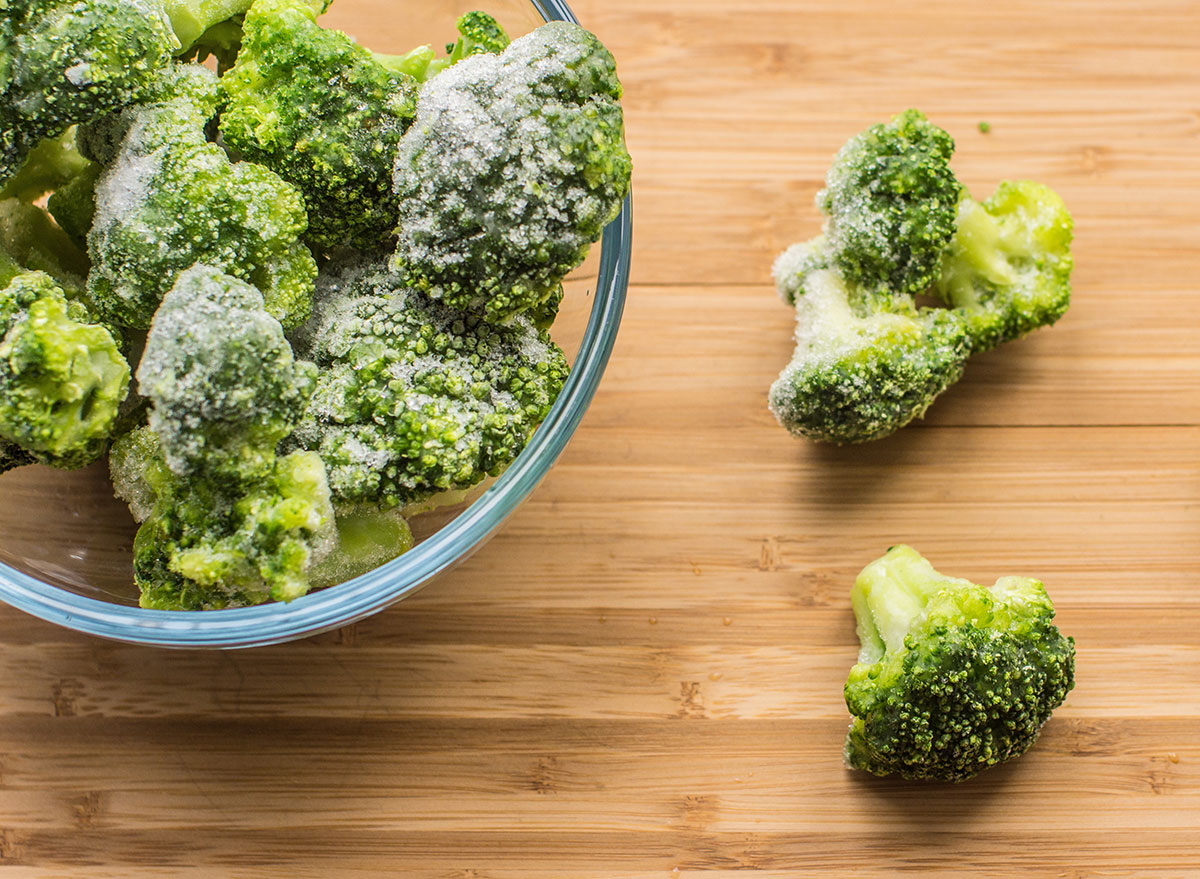
- Spinach
- Kale
- Cauliflower
- Broccoli
- Corn
Just as with fruits, vegetables are frozen at their peak, so you’ll be getting the same nutritious boost of phytonutrients (plant nutrients with potent antioxidant and anti-inflammatory benefits) as you do from fresh produce. Not to mention, frozen veggies can sub the fresh kind in most recipes—just take into account that they’ll release some extra liquid when thawing.
Recipes to try: 17 Delicious Things to Do With Frozen Produce, 20 Quick Recipes Made With Frozen Foods
12. Canned fish
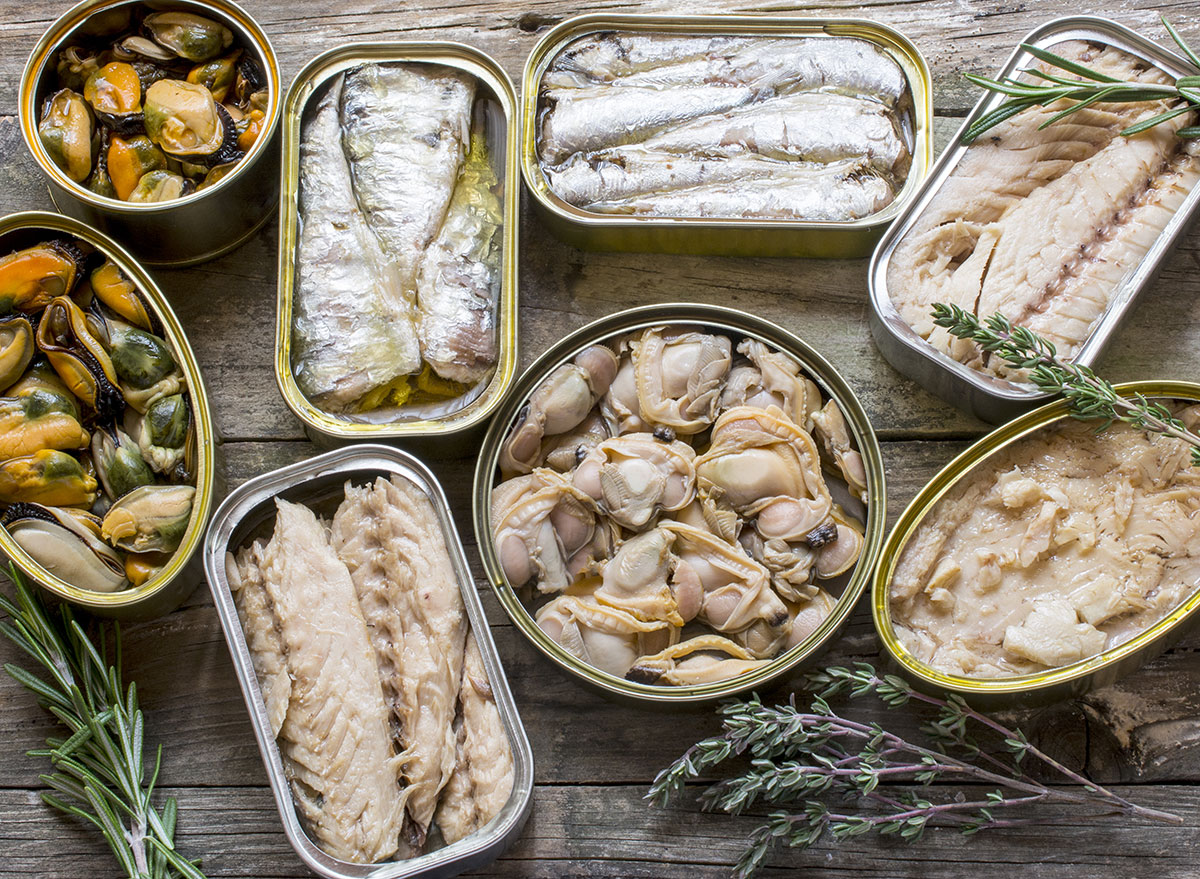
- Tuna
- Salmon
- Sardines
- Anchovies
When you want to hold off on making that next grocery trip for some fresh meat, make canned tuna or salmon your go-to source of protein (besides beans, of course). Feller recommends canned fish because it’s not only convenient, it’s also rich in anti-inflammatory omega-3 fatty acids.
If you only keep canned tuna in your pantry for tuna salad, let this quarantine be your opportunity to try using it in new ways! We like to layer it on some crusty toast with a splash of olive oil, or mix it into pasta salads with tomatoes and olives. When it comes to canned salmon, we like it in salads and sandwiches. Sardines are great for a quick homemade pate, and anchovies . . . well, they just bring that umami burst of flavor to whatever needs it (soups, pasta sauces, and even dips).
Recipes to try: 13 Healthy Things You Can Make With a Can of Tuna, 15 Creative Ways to Use Canned Fish
13. Low-sodium soups
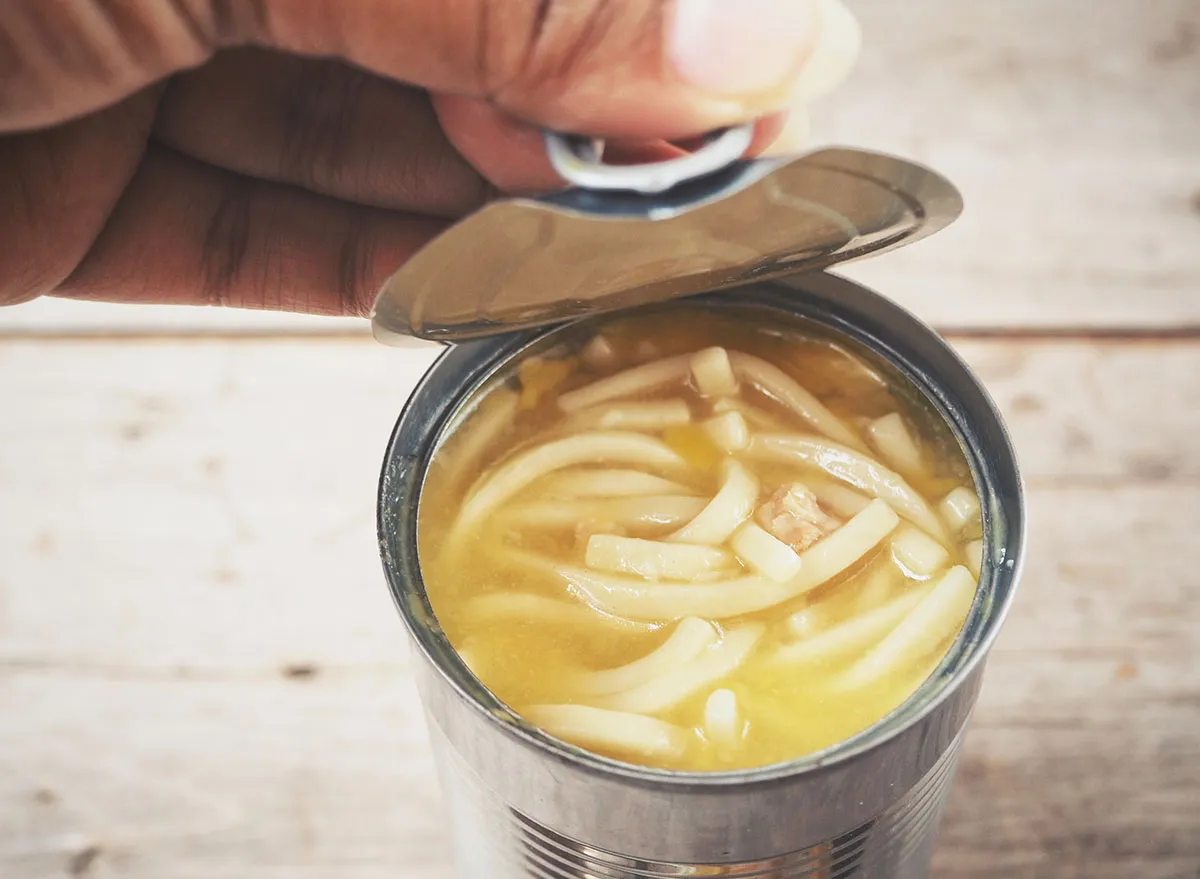
Restaurants are off-limits, the wait for takeout is an hour, and don’t even get us started on how long delivery will take. If you need a quick meal when you’re sick of cooking (or just sick), nothing is as healing as knowing that hot soup is just a few minutes away.
The healthiest soups will have a balance of carbs, fiber, and protein and very low levels of sodium. Our dietitians recommend these healthy Progresso soups as best canned soup options. And if you’re looking to doctor up that old dusty can of Campbell’s soup you’ve had in your pantry for months, use the different varieties in soups, pasta sauces, and casseroles.
Recipes to try: 15 Dinner Recipes You Can Make With a Can of Campbell’s Soup
14. Low-sodium broths
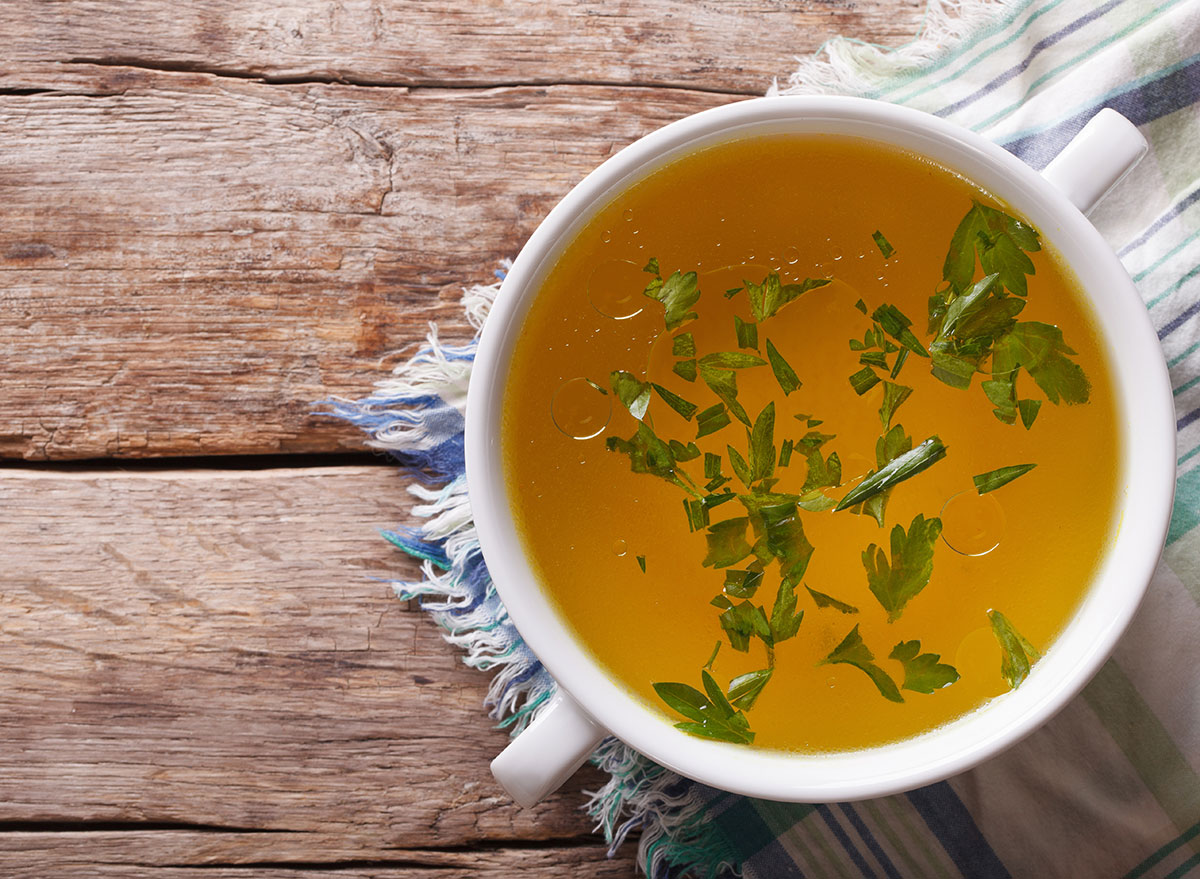
- Chicken broth
- Beef broth
- Veggie broth
Yes, you can make soup with just about anything in your fridge and some water, but Feller recommends stocking up on low-sodium broths and using them as flavor enhancer. Just make sure they are truly low in sodium (under 150 milligrams per serving), which will help prevent bloating and reduce the strain on your heart.
You don’t have to only use broths as soup bases, either. Use them to add flavor to any recipe that calls for water was a base—risottos, slow-cooker meat recipes, and sauces and gravies.
Recipes to try: 42+ Healthy Slow Cooker Recipes, 20 Best Broth-Based Soups for Weight Loss
15. Olive oil

Every healthy diet should include a good amount of healthy fats. And because we’re talking pantry essentials here, we can’t recommend stocking up on avocados. While the fatty fruits are rich in heart-healthy monounsaturated fats, we all know they tend to go bad much faster than it takes for them to ripen on your counter.
For a shelf-stable version of healthy fats, we recommend olive oil. Feller loves how versatile olive oil is—you’ll be using it to fry up crispy chickpeas, sauté veggies, drizzle on top of bread, or preserve your garlic.
16. Alliums
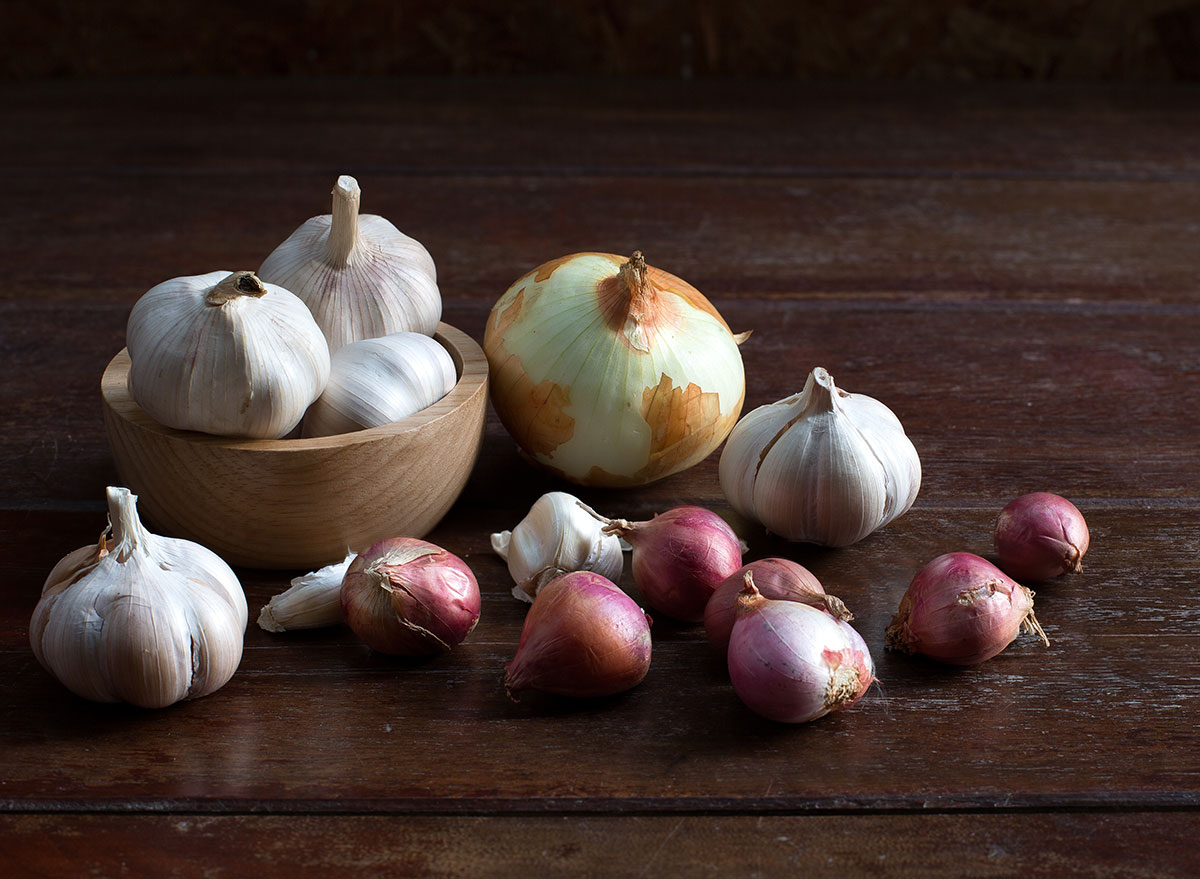
- Onions
- Garlic
- Shallots
You have to keep your gut happy when you’re shut off at home. It plays a role in many major biological functions such as your immune system, mental health, skin health, inflammation response, and appetite management. Read that list over again and you’ll soon understand how important it will be to maintain proper gut health during this time.
You know probiotics are great for your gut, but did you know that prebiotics are just as important? These are a food source for the beneficial bacteria in your gut, and they are found in foods like onions, garlic, and leeks. And believe it or not, eating raw alliums can supercharge their health benefits—raw onions have a higher level of beneficial organic sulfur compounds, while raw garlic is one of the most effective natural antibiotics.
Let’s be honest, there’s no home cooking without garlic and onions. They make up the flavor base of most things we know and love. Just make sure you store them properly to keep them at their peak quality.
Recipes to try: Flavorful Caramelized Onions, Easy Pickled Onions, Simple and Sweet Roasted Garlic
17. Ginger

If you’re starting to feel bloated from being cooped up inside all day, make sure to add ginger to your next grocery delivery or supermarket run. (Also, make sure you go on a walk as often as possible.)
Ginger is known for its anti-bloat properties that help soothe troubled stomachs. This root lasts a long time in the refrigerator, but you can also keep it in the freezer (which also makes it easier to grate). Use ginger in stir fries, slice it to make ginger tea, or use it to flavor soups, smoothies, and soaked oats.
Recipes to try: Mango Ginger Overnight Oats, 15 Flavorful Asian Recipes Better Than Takeout
18. Nuts
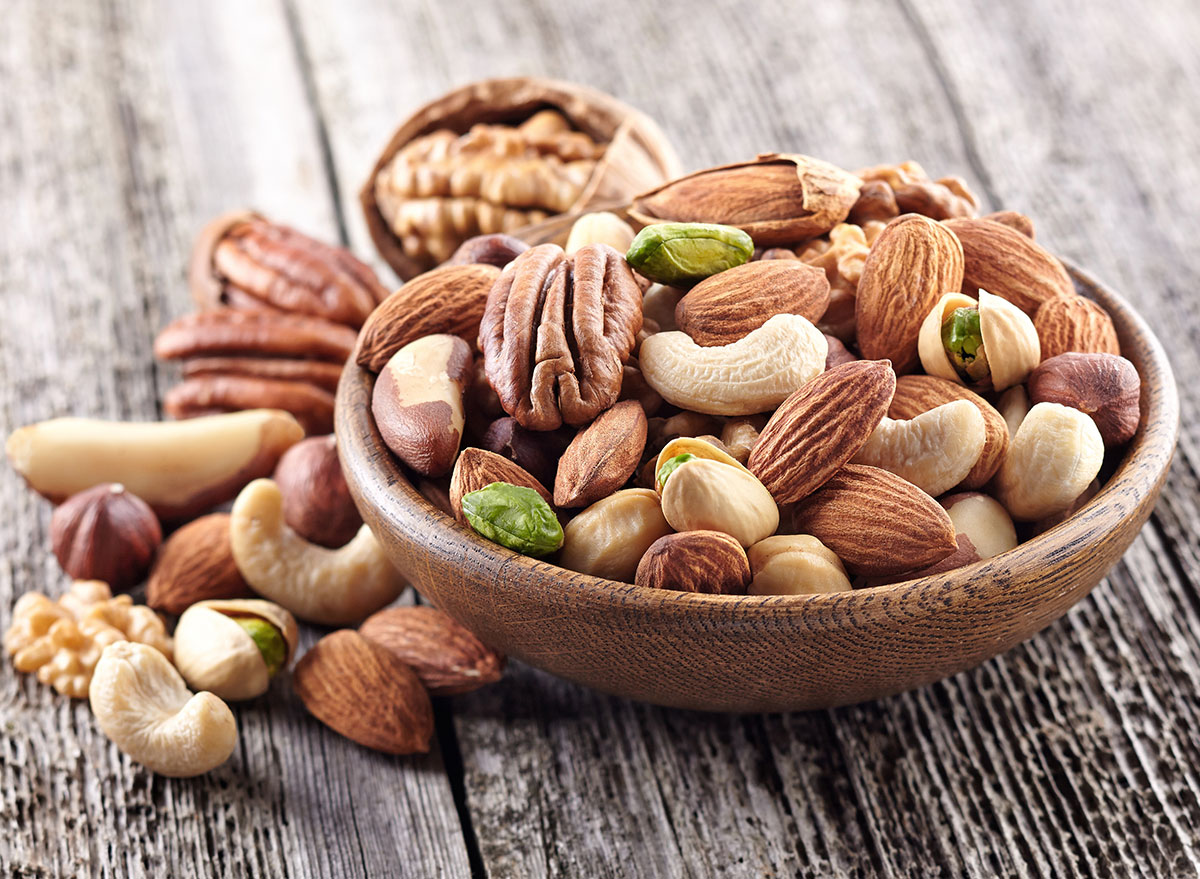
- Almonds
- Pistachios
- Walnuts
- Hazelnuts
- Cashews
- Pecans
Whether you prefer them raw or ground into a butter, nuts are the perfect healthy snack when holed up at home. One of the most common responses to being bored and stressed is—you guessed it—snacking. To maintain a healthy diet, forego greasy chips, and opt for unsalted nuts instead. Feller likes nuts as a source of “protein, fiber, and vitamin E.”
Besides being great for snacking, nuts and their butters are an awesome fatty flavor supplement to salads, smoothies, and baked goods.
Recipes to try: 15 Perfect Pistachio Recipes, How to Make Almond Flour, Easy Way to Make Almond Milk at Home
19. Seeds
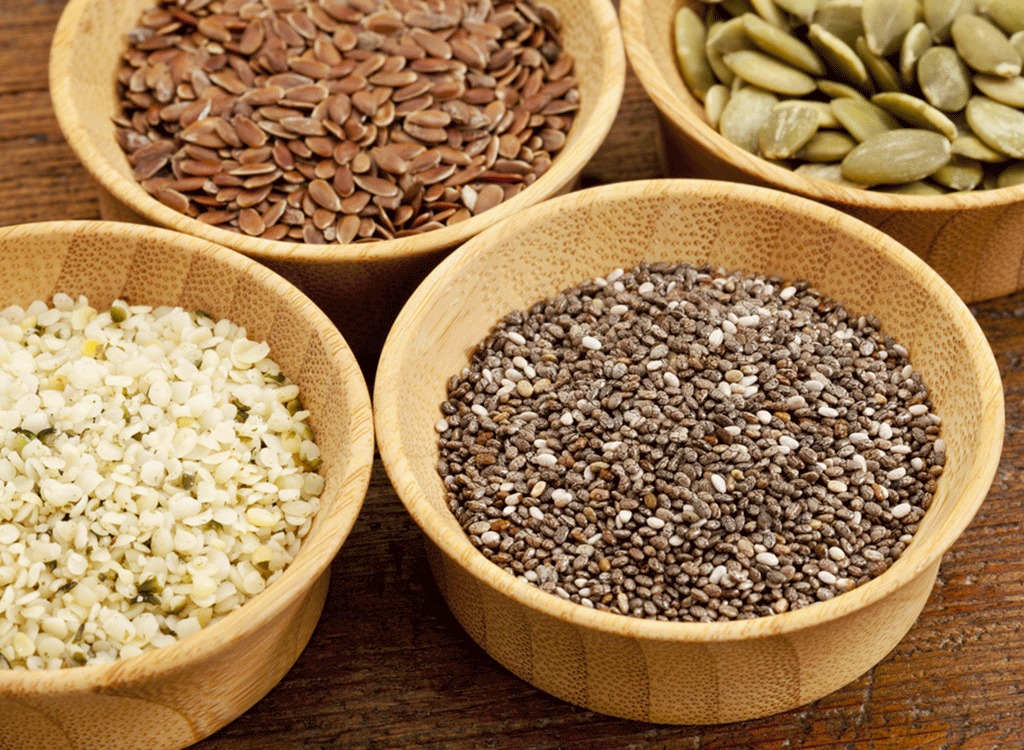
- Hemp
- Pumpkin
- Sesame
- Chia
- Sunflower
- Flax
Think of seeds like supplements. These little foods pack a huge micronutrient punch. For example, an ounce of pumpkin seeds delivers nearly 40 percent DV of magnesium (essential for energy production). Flaxseeds and chia seeds made our list of top 10 sources of omega-3 fatty acids (a potent anti-inflammatory nutrient), because just one serving delivers more than an entire day’s worth of omega-3s.
All seeds also happen to be amongst the most fiber-rich foods, which is an essential macronutrient to ramp up when you’re eating a lot of carbs.
It’s good to stock up on seeds no matter what your cooking abilities are. Sprinkle them over salads, roasted vegetables, oatmeal, and add them to smoothies.
Recipes to try: 23 Ways to Eat Chia Seeds, Healthy Flaxseed Buttermilk Pancakes, Overnight Oats with Berries and Cream, Homemade Tahini
20. Plant-based milk
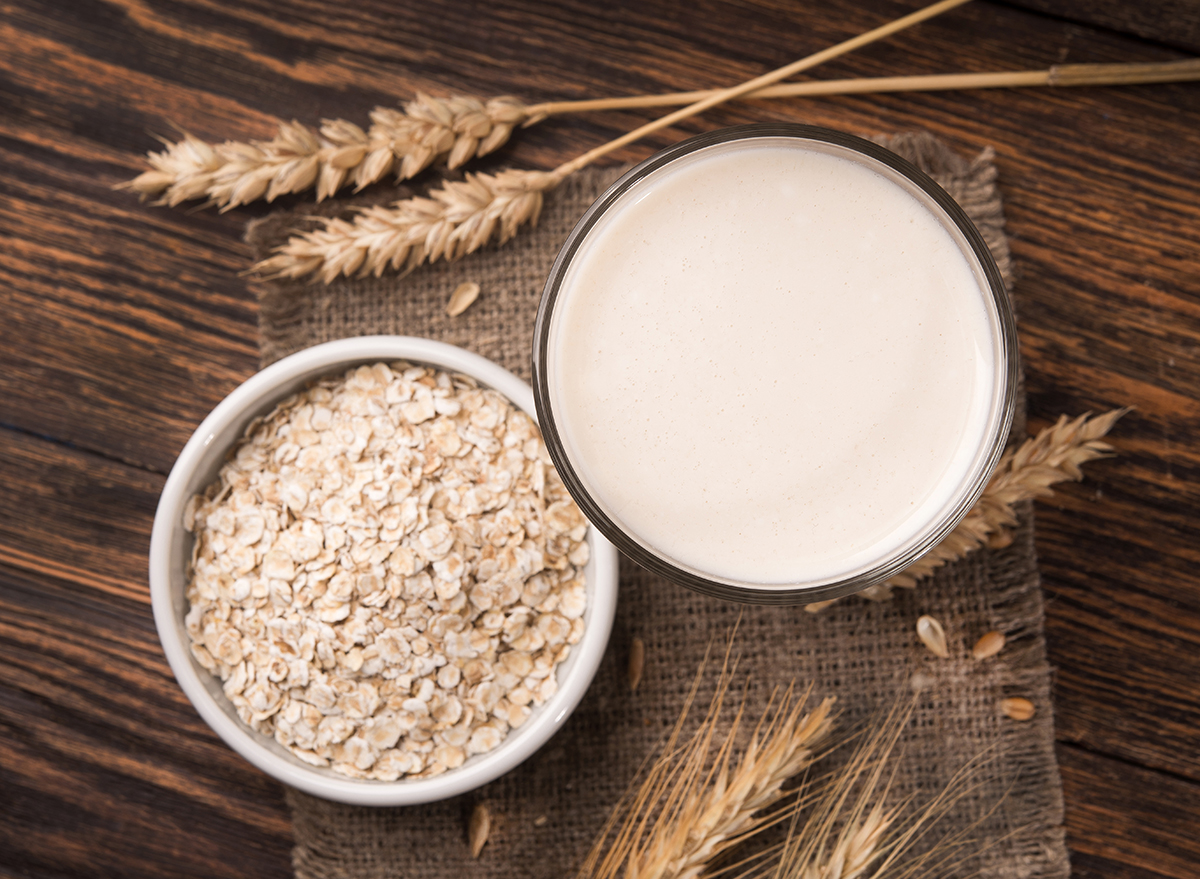
- Almond milk
- Oat milk
- Soy milk
- Hemp milk
- Coconut milk
They’ll last longer than regular milk and can be used for things like smoothies, oatmeals and overnight oats, lattes, and even as a dairy sub in pancakes, waffles, and baking. Some brands are better than others, so choose milks that list the smallest number of ingredients.
Recipes to try: 50 Healthy Overnight Oats Recipes, 10 Plant-Based Smoothies
Eat This, Not That! is constantly monitoring the latest foods news as it relates to COVID-19 in order to keep you healthy, safe, and informed (and answer your most urgent questions). Here are the precautions you should be taking at the grocery store, the foods you should have on hand, meal delivery services and restaurant chains offering takeout, and ways you can help support those in need. We will continue to update these as new information develops. Click here for all of our COVID-19 coverage, and stay healthy.
